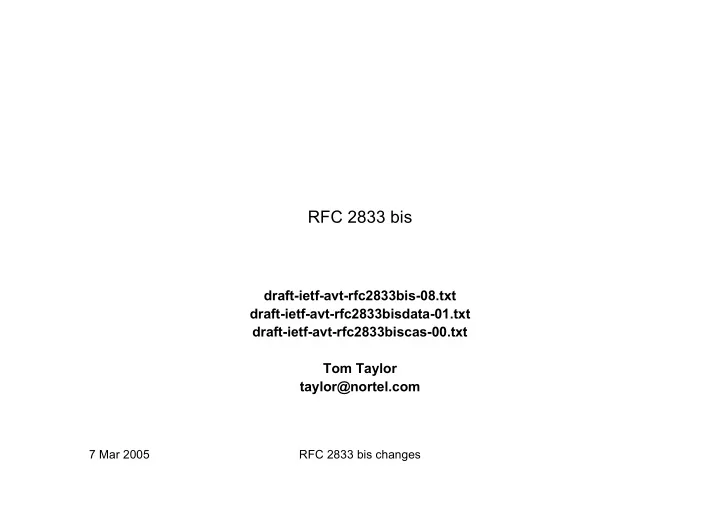

RFC 2833 bis draft-ietf-avt-rfc2833bis-08.txt draft-ietf-avt-rfc2833bisdata-01.txt draft-ietf-avt-rfc2833biscas-00.txt Tom Taylor taylor@nortel.com 7 Mar 2005 RFC 2833 bis changes
Overview of Changes From RFC 2833 • Split into three documents – core specification of telephone-event and tone payloads plus DTMF event codes (rfc2833bis) – modem-related event codes (rfc2833bisdata) – CAS-related event codes (rfc2833biscas) • New core provisions – long-duration events – multiple events per packet – state events • Many additions to fill in missing details – for example, mapping of ABCD bits to event codes • Some changes to RFC 2833 procedures – no longer required to support DTMF – receiver MUST indicate what events are supported – volume applicable to tone events other than DTMF • IANA registry established for event codes 7 Mar 2005 RFC 2833 bis changes
Changes for Modem-Related Events • Reorganized by source standard – added more description to put events into context • Added event codes – 53 = CI – 54 = T.30 preamble flag – 52 = ANS2225 for text telephony – 55-61 provide a set of indicators for text telephony or general VBD 7 Mar 2005 RFC 2833 bis changes
Changes for CAS-related events • Added signalling systems – SS No. 5 – R2 • Revoked a number of event code assignments – 143 = MF S3 – 160 = Wink – 161 = Wink off – 162 = Incoming seizure – 163 = Seizure – 164 = Unseize circuit – 165 = Continuity test – 166 = Default continuity tone – 170 = Continuity verified – 171 = Loopback – 172 = Old milliwatt tone (1000 Hz) – 173 = New milliwatt tone (1004 Hz) • All line signalling now mapped to ABCD event codes – different mapping for each signalling system 7 Mar 2005 RFC 2833 bis changes
Changes for CAS-Related Events (cont’d) • Changed some event code assignments – 138-142 (MF start and stop codes) – continuity test tones were spread over five codes, now just 167 for check and 168 for verify • New event codes – 174 = metering pulse – 175 = trunk unavailable – 176-205 for R2 register signals (15 forward, 15 backward) 7 Mar 2005 RFC 2833 bis changes
Open Issues • Suitability of RFC 2193 for simultaneous transport of VBD as G.711 (e.g.) and modem events (Colin). • Whether tone payload requires at least one frequency, or zero frequencies allowed with interpretation of silence. (Latter recommended.) • How to express amplitude of modulation in tone payload (discussion on next chart). • Assignment of MF start and stop code events 138-142 to match ordering by lower frequency (proposed). • Mapping of A and AB events into full ABCD set. (Recommended that used bits be propagated to unused ones.) 7 Mar 2005 RFC 2833 bis changes
Specification of Amplitude of Modulation Currently applies only to ANSam, /ANSam. In RFC 2833, also applied to some subscriber line signals. 100% 50% “Modified answer tone ANSam consists of a sinewave signal at 2100 ± 1 Hz with phase reversals at an interval of 450 ± 25 ms, amplitude-modulated by a sinewave at 15 ± 0.1 Hz. The modulated envelope shall range in amplitude between (0.8 ± 0.01) and (1.2 ± 0.01) times its average amplitude.” (ITU-T Rec. V.8) 7 Mar 2005 RFC 2833 bis changes
Where Do 7 Bits (for +/- 1%) Come From? 0 8 16 24 Modulation Hz T Volume Duration RRRR Frequency 1 RRRR Frequency 2 Using R bits is ugly. Maybe we just admit that modulation is not a working part of the payload specification. 7 Mar 2005 RFC 2833 bis changes
Recommend
More recommend